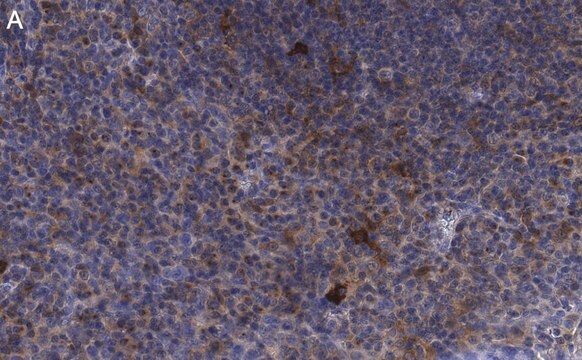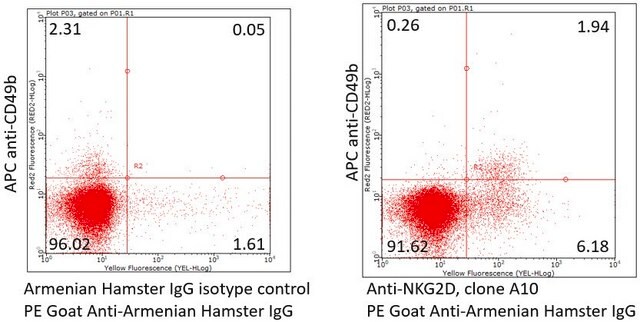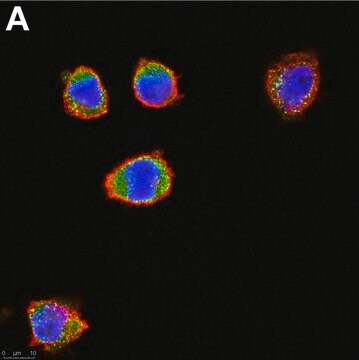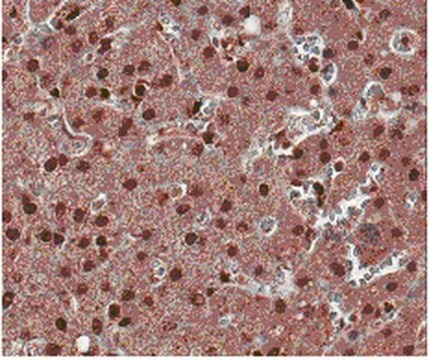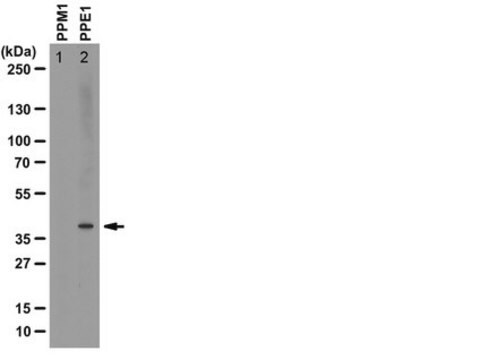MABF2101
Anti-CD25 Antibody, clone 7D4
About This Item
Empfohlene Produkte
Biologische Quelle
rat
Qualitätsniveau
Konjugat
unconjugated
Antikörperform
purified antibody
Antikörper-Produkttyp
primary antibodies
Klon
7D4, monoclonal
Mol-Gew.
calculated mol wt 30.72 kDa
Aufgereinigt durch
ion-exchange chromatography
Speziesreaktivität
mouse
Verpackung
antibody small pack of 100 μg
Methode(n)
flow cytometry: suitable
immunocytochemistry: suitable
immunohistochemistry (formalin-fixed, paraffin-embedded sections): suitable
immunoprecipitation (IP): suitable
inhibition assay: suitable
radioimmunoassay: suitable
Isotyp
IgM
Epitopsequenz
Extracellular domain
Protein-ID-Hinterlegungsnummer
UniProt-Hinterlegungsnummer
Versandbedingung
dry ice
Posttranslationale Modifikation Target
unmodified
Verwandte Kategorien
Allgemeine Beschreibung
Spezifität
Immunogen
Anwendung
Evaluated by Immunocytochemistry in RAW264.7 cells.
Immunocytochemistry Analysis (ICC): 1:25 dilution of this antibody detected Interleukin-2 receptor subunit alpha (CD25) in RAW264.7 cells.
Tested Applications
Inhibition: A representative lot inhibited proliferation of the HT2 cells and of IL-2-dependent CTLL cells. (Malek, T.R., et al. (1983). Proc Natl Acad Sci USA.;80(18):5694-8; Ortega, G., et al. (1984). J Immunol.;133(4):1970-5; Pollard, A.M., et al. (1990). J Exp Med.;172(1):159-67; Nihei, J. et al. (2014). Eur J Microbiol Immunol (Bp).;4(2):128-37; Teege, S., et al. (2015). Sci Rep.;5:8959).
Immunohistochemistry Applications: A representative lot detected CD25 in Immunohistochemistry applications (Nihei, J. et al. (2014). Eur J Microbiol Immunol (Bp).;4(2):128-37).
Immunoprecipitation Analysis: A representative lot immunoprecipitated CD25 in Immunoprecipitation applications (Malek, T.R., et al. (1983). Proc Natl Acad Sci USA.;80(18):5694-8; Ortega, G., et al. (1984). J Immunol.;133(4):1970-5).
Flow Cytometry: A representative lot detected CD25 in Flow Cytometry applications (Malek, T.R., et al. (1983). Proc Natl Acad Sci USA.;80(18):5694-8; Ortega, G., et al. (1984). J Immunol.;133(4):1970-5; Malek, T.R., et al. (1985). J Immunol.;134(4):2405--13; Kohm, A.P., et al. (2006). J Immunol.;176(6):3301-5; Nihei, J. et al. (2014). Eur J Microbiol Immunol (Bp).;4(2):128-37; Teege, S., et al. (2015). Sci Rep.;5:8959).
Radioimmunoassay: A representative lot detected CD25 in Radioimmunoassay applications (Ortega, G., et al. (1984). J Immunol.;133(4):1970-5).
Note: Actual optimal working dilutions must be determined by end user as specimens, and experimental conditions may vary with the end user
Physikalische Form
Lagerung und Haltbarkeit
Sonstige Hinweise
Haftungsausschluss
Sie haben nicht das passende Produkt gefunden?
Probieren Sie unser Produkt-Auswahlhilfe. aus.
Lagerklassenschlüssel
10 - Combustible liquids
WGK
WGK 2
Flammpunkt (°F)
Not applicable
Flammpunkt (°C)
Not applicable
Analysenzertifikate (COA)
Suchen Sie nach Analysenzertifikate (COA), indem Sie die Lot-/Chargennummer des Produkts eingeben. Lot- und Chargennummern sind auf dem Produktetikett hinter den Wörtern ‘Lot’ oder ‘Batch’ (Lot oder Charge) zu finden.
Besitzen Sie dieses Produkt bereits?
In der Dokumentenbibliothek finden Sie die Dokumentation zu den Produkten, die Sie kürzlich erworben haben.
Unser Team von Wissenschaftlern verfügt über Erfahrung in allen Forschungsbereichen einschließlich Life Science, Materialwissenschaften, chemischer Synthese, Chromatographie, Analytik und vielen mehr..
Setzen Sie sich mit dem technischen Dienst in Verbindung.